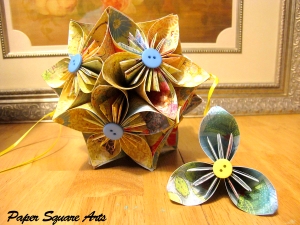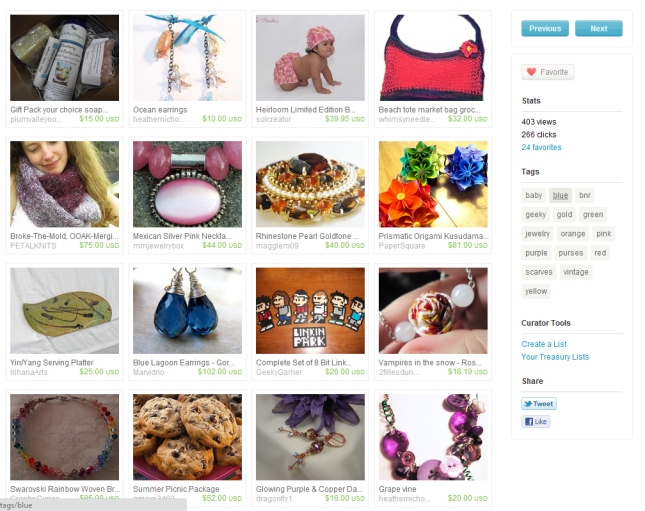Christmas in July Sale Event! 10% off your entire purchase! Use code julyxmas during checkout to receive this discount! Limited Time Only!
Category Archives: ETSY
A little History on Kusudama
The flowers I make are called Kusudama. (like this one below)
 Although Kusudama is an ancient form of art, it is not well known around the United States as much as it is in Asia. In effort to educate those that are curious, I will share a little bit of history.
Although Kusudama is an ancient form of art, it is not well known around the United States as much as it is in Asia. In effort to educate those that are curious, I will share a little bit of history.
Kusudama
The Japanese kusudama (薬玉; lit. medicine ball) is a paper model that is usually (although not always) created by sewing multiple identical pyramidal units (usually stylized flowers folded from square paper) together through their points to form a spherical shape. Alternately the individual components may be glued together. (e.g. the kusudama in the lower photo is entirely glued, not threaded together) Occasionally, a tassel is attached to the bottom for decoration.
Kusudama originate from ancient Japanese culture, where they were used for incense and potpourri; possibly originally being actual bunches of flowers or herbs. The word itself is a combination of two Japanese words kusuri, Medicine, and tama, Ball. They are now typically used as decorations, or as gifts.
The kusudama is important in origami particularly as a precursor to the modular origami genre. It is often confused with modular origami, but is not such because the units are strung or pasted together, instead of folded together as most modular construction are made.
It is, however, still considered origami, although origami purists frown upon using its characteristic technique of threading or gluing the units together, while others recognize that early traditional Japanese origami often used both cutting (see thousand origami cranes or senbazuru) and pasting, and respect kusudama as an ingenious traditional paper folding craft in the origami family.
Modern origami masters such as Tomoko Fuse have created new kusudama designs that are entirely assembled without cutting, glue or thread except as a hanger.
Etsy BNR help – What it is and how it works
If you are new to Etsy you may have read about BNRs, it stands for Buy and Replace and it is a great way to:
- Meet wonderful sellers like you
- Promote your shop
- Purchase wonderful items from other shops
- Get exposure, bring sales and feedback to your shop.
- Have a lot of fun!
A BNR on Etsy is a curated treasury list or collection of items from different shops. The curator of the treasury will post the rules of the BNR for everyone to see. They normally look like this:
NO MINIMUM TO BUY IN!
1. Call out shop in CAPS before buying
2. Wait for permission to buy
3. After purchase post TRANSACTION LINK
Two spots MAX!
Our team:
http://www.etsy.com/teams/9379/martinis-bnr
Each BNR has their own rules, some had a minimum to buy in, others don’t.
So this is how it works:
Once you stumble upon a BNR or get invited to one, you basically shop around the featured shops and find something you like, if you find something then you will post a comment asking permission to the curator to shop for that specific shop ( i.e : PAPERSQUARE please! ) once you get the ok from the curator (this is to ensure nobody else is shopping at the shop you want), purchase your item and post the transaction link (the link will look like this: http://www.etsy.com/transaction/51907856 )
Now, one of your shop items will be featured on the treasury and you will get a chance to be bought out!
This is what a BNR looks like (click on the image to go to the team that curated this BNR – Martini’s BNRs)
Tips from other BNR fans and friends around Etsy:
- Always check out the curator’s shop! It’s tons of work to curate and curate well.
- Chat – you should always chat a bit and network with people. Try to make time if you plan to buy in to stick around for a bit.
- Say Hi to the newbies. They tend to get lost quickly in chatter.
- Be willing to promote. Post the BNR link in your teams, and around the internet.
- Chatting is super important, if no one is talking, I will assume no one is there and I will leave.
- Be prepared to have a coupon. It doesn’t have to be much, but you are more likely to get a sale.
- Don’t expect the curator to be able to keep track of everyone coming in. This is a lot of work, so everyone needs to be friendly and help.
- Don’t complain about not getting sales, it turns people off.
- If you’re the curator, make sure you are actively attending your BNR.
- Favorite the BNR and your fellow sellers items
- It is also not the curator’s job to get you a sale or buy from your shop if you don’t get a sale. If your items are very expensive or not portrayed well, that is something you have to reconcile. Buying in does not guarantee a sale.
- Most of all, have fun, meet great people, be polite and professional, you are portraying your business and the human behind your shop, keep that in mind, everything you say is public.
Thank you to everyone in Martini’s BNR for your input and participation to bring this post to life. I am a new member of this team and could not be happier. Everyone looking for a fun and professional team should join at:
http://www.etsy.com/teams/9379/martinis-bnrs
Shops that helped put this post together:
IrihanaArts – Handmade Ceramics – http://www.etsy.com/people/IrihanaArts
Whimsy Needles – http://www.etsy.com/shop/whimsyneedles
41StarsStudio – photography and jewelry http://www.heathernichols.etsy.com
http://www.41starsstudio.etsy.com












